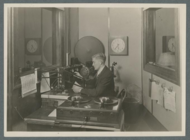| Frequency | 550 kHz |
|---|---|
| Programming | |
| Format | Public Radio - News - Talk |
| Affiliations | |
| Ownership | |
| Owner | Oregon Public Broadcasting |
| History | |
| First air date | January 23, 1923; 101 years ago (1923-01-23) |
| Former call signs | KFDJ (1922–1925) |
| Call sign meaning | Oregon Agricultural College (former name of Oregon State University) |
| Technical information | |
| Licensing authority | FCC |
| Facility ID | 50587 |
| Class | B |
| Power | 5,000 watts |
| Transmitter coordinates | 44°38′12″N 123°11′33″W / 44.63667°N 123.19250°W / 44.63667; -123.19250 |
| Links | |
| Public license information | |
| Webcast | Listen live |
| Website | opb.org |
KOAC (550 AM) is a non-commercial, listener supported, public radio station licensed to Corvallis, Oregon. The station is owned by Oregon Public Broadcasting, and airs OPB's news and talk programming, consisting of syndicated shows from National Public Radio, American Public Media and the Public Radio Exchange, as well as locally produced offerings. The studios and offices are on South Macadam Avenue in Portland.
KOAC is powered at 5,000 watts. To protect other stations on 550 AM from interference, it uses a directional antenna with a two-tower array. The transmitter is off NE Granger Avenue near U.S. Route 20 in Albany. Due to its transmitter power and location near the bottom of the AM dial, the signal during the day, covers most of Oregon's densely populated areas. It provides at least secondary coverage from Portland to Roseburg. It is the only directional AM radio station in the United States which uses a shunt-fed antenna.
History

KOAC is one of the oldest radio stations in Oregon. It was first licensed, with the sequentially assigned call letters KFDJ, to the Oregon State Agricultural College (now Oregon State University) on December 7, 1922. It made its debut broadcast on January 23, 1923; 101 years ago (January 23, 1923). Its call sign became KOAC in late 1925. KOAC was one of a number of AM stations started by universities in the early days of radio as a way to experiment in the new medium and train future broadcasters. Unlike most early radio stations that had to share a frequency with other stations, KOAC was eventually able to have a frequency to itself full-time. In the 1930s, it was powered at 1,000 watts.

In 1932, the station's management was transferred from Oregon State College to the Oregon State Board of Higher Education's General Extension Division. However, the state headquarters and network studios remained at the university's campus in Corvallis.

The first broadcasts by KOAC were made from the original campus studio in Kearny Hall in 1923.
From 1928 to 2006, KOAC's studios were on campus in Covell Hall, where OSU faculty and students broadcast educational programs and later live news programs across the state. Starting in the 1950s, the board signed on a number of simulcast radio stations in Portland, Eugene and other communities. It also began a sister network of PBS television stations fronted by KOAC-TV (channel 7, which signed on in 1957). This group became known as Oregon Educational Broadcasting, which evolved into the Oregon Educational and Public Broadcasting Service in 1971.
From the 1950s to the 80s, KOAC 550 was the flagship station of Oregon Public Radio. The radio and TV studios remained on the Corvallis campus until 1981. The network was then spun-off from the Board of Higher Education and became a separate state agency known as Oregon Public Broadcasting. At that time, satellite stations in Portland, KOAP-FM-TV (now KOPB-FM-TV), became the flagship stations.
Main article: Oregon Public BroadcastingReferences
- "Facility Technical Data for KOAC". Licensing and Management System. Federal Communications Commission.
- "Radio locator: Corvallis, Oregon". Theodric Technologies LLC. 2012. Retrieved March 10, 2012.
- Radio-Locator.com/KOAC-AM
- ^ "A selection from a decade of visits to tower and studio sites in the Northeast and beyond".
- Oregon State Agricultural College entry, Education's Own Stations by S. E. Frost, 1937, pages 306-307.
- "Alterations and Corrections", Radio Service Bulletin, December 31, 1925, page 6.
- Broadcasting Yearbook 1935 page 50. Retrieved Aug. 26, 2024.
- Horton, Kami. "It all started as a lab experiment: A century ago, the broadcaster that became OPB was born". opb.org. OPB. Retrieved 3 August 2023.
- munsot, ed (6 March 2013). "Friday Feature: Happy birthday to KOAC!". oregonstate.edu. OSU. Retrieved 2 August 2023.
- KOAC timeline from the Oregon State University website
External links
- FCC History Cards for KOAC
- opb.org
- Facility details for Facility ID 50587 (KOAC) in the FCC Licensing and Management System
- KOAC in Nielsen Audio's AM station database
| Radio stations in Salem, Corvallis, Albany, and Lebanon, Oregon (mid-Willamette Valley) | |||||
|---|---|---|---|---|---|
| By AM frequency | |||||
| By FM frequency |
| ||||
| NOAA Weather Radio frequency | |||||
| Digital radio by frequency & subchannel | |||||
| By call sign |
| ||||
| Defunct | KYTE 102.7 FM | ||||
| |||||
| NPR member stations in the state of Oregon | |
|---|---|
| OPB stations | |
| Jefferson Public Radio Classics & News stations |
|
| Jefferson Public Radio News & Information stations | |
| Jefferson Public Radio Rhythm & News stations | |
| KLCC stations |
|
| KMUN stations |
|
| Other stations | |
| See also List of NPR stations | |
This article about a radio station in Oregon is a stub. You can help Misplaced Pages by expanding it. |